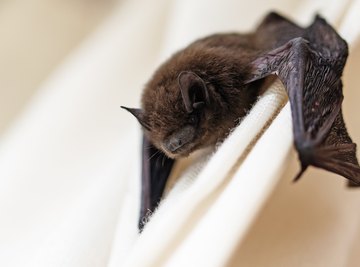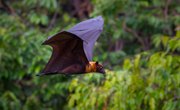
Bats are fascinating and incredibly diverse mammals. The smallest species, Kitti's hog-nosed bat, has a wingspan of just 5.91 in, whereas the largest, the giant gold-crowned flying fox, can have a wingspan of 5 ft 7 in. There are over 1200 known species of bat, making them the second-largest order of mammals. In fact, 20% of all classified mammal species are bats!
They are mammals, and therefore have many common mammalian features: such as being warm-blooded and having fur. The main adaptation that separates bats from other mammals, however, is their ability to fly. Some other mammals like so-called flying squirrels and flying lemurs cannot actually fly: in fact, they glide. Bats are the only mammals with true powered flight.
Beyond powered flight, bats have a number of other unique adaptations to their varied habitats.
TL;DR (Too Long; Didn't Read)
Bats have a broad range of unique physical and behavioral adaptations that allow them to survive in a range of environments and on a variety of diets.
Physical Adaptations for Movement: Lightweight Mammalian Wings
Bats are the only mammals that are able to fly. Adaptations that enable them to fly effectively include long arms with "finger" bones that are thin and light but are also capable of supporting and manipulating the wing membranes. Bat flight is also aided by fused bones in areas such as the skull. This helps to make the bat light in weight. Although these wings are mainly used for flight, they also have other uses such as forming pouches to carry or catch prey with.
Physical Adaptations for Sustenance: Specialized Mouth and Tongue
Different species of bats have adapted to feed on a wide range of food sources. Although most bats feed on insects, the diets of some bats include:
- fruit
- nectar
- blood
- frogs
- birds
- fish
Different species have different adaptations to help them hunt or gather their specific sources of food.
Physical Adaptations for Navigation: Echolocating Voice and Ears
The majority of bats use echolocation, also called bio-sonar, to navigate and hunt for food. The typical exception is fruit bats, who rely largely on sight in order to find their way around. While hunting insects at night, bats produce a series of high-pitched sounds from their noses or mouths. Most humans are unable to hear these sounds. The sound waves bounce back when they meet an object such as an insect, allowing the bat to "see" with sound.
The inner ear and auditory cortex in the brain of most bats is specially-adapted to understand these sounds in the ultrasonic range.
Behavioral Adaptation for Safety: Upside-Down Nocturnality and Hibernation
Bats are nocturnal animals, normally sleeping during the day in shelters such as caves or empty buildings. This behavioral adaptation enables them to hide from predators while they are asleep and vulnerable. They leave their shelters to hunt at night: as most species of bats rely on hearing to navigate and hunt their prey, daylight is not essential. Flying at night also prevents bats’ wings from absorbing excessive amounts of heat.
Bats also sleep upside down, holding on with their feet rather than their hands. This leaves their wings free to take off in flight whenever they need to.
Bats in northern climes are also able to hibernate through the winter. When bats go into hibernation, they reduce their body temperature which enables them to conserve energy and find a relatively warm, humid shelter.
References
About the Author
Born in Norfolk, United Kingdom, Hayley Ames' writing experience includes blog articles for a travel website. Ames was awarded a Bachelor of Arts in English language and literature from the University of Sheffield in the United Kingdom.
